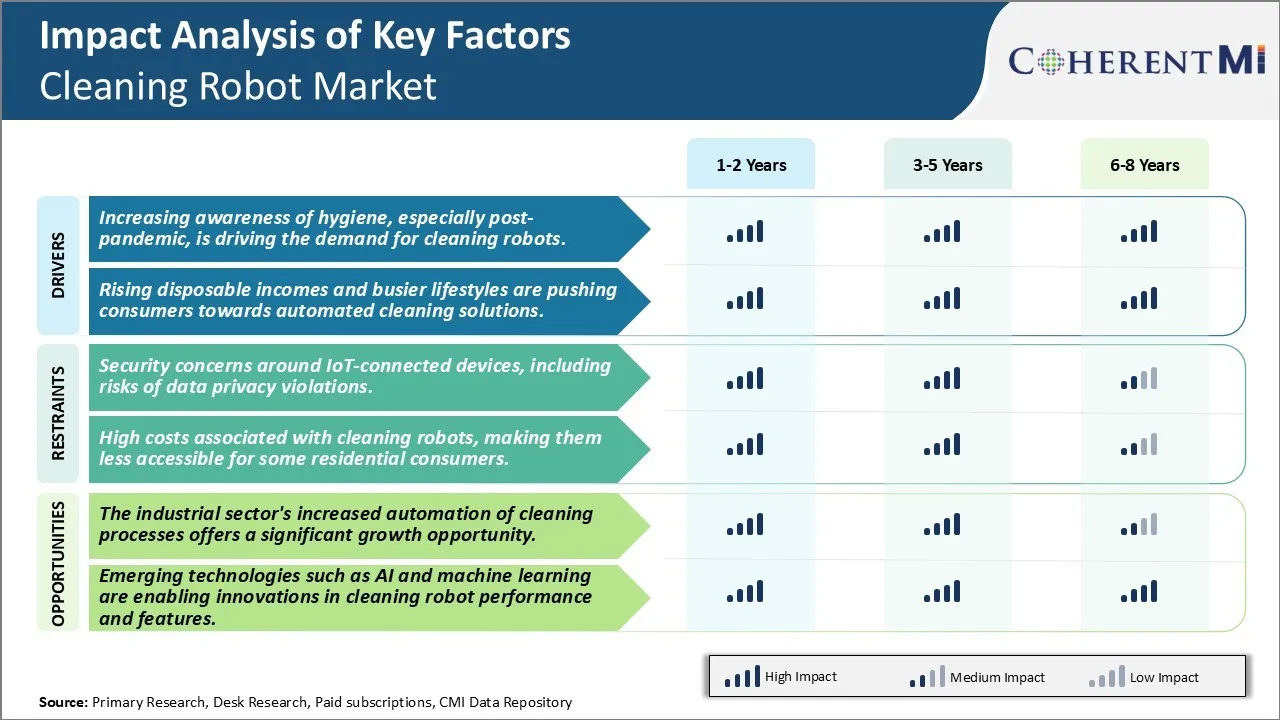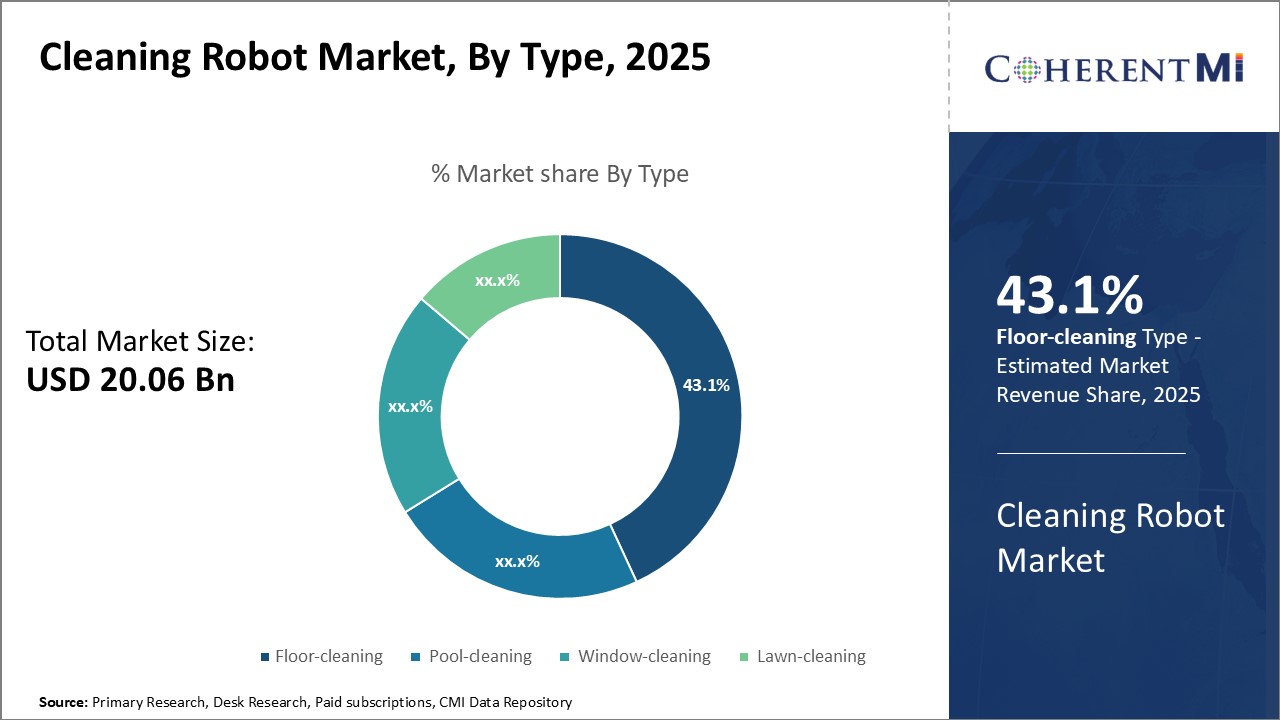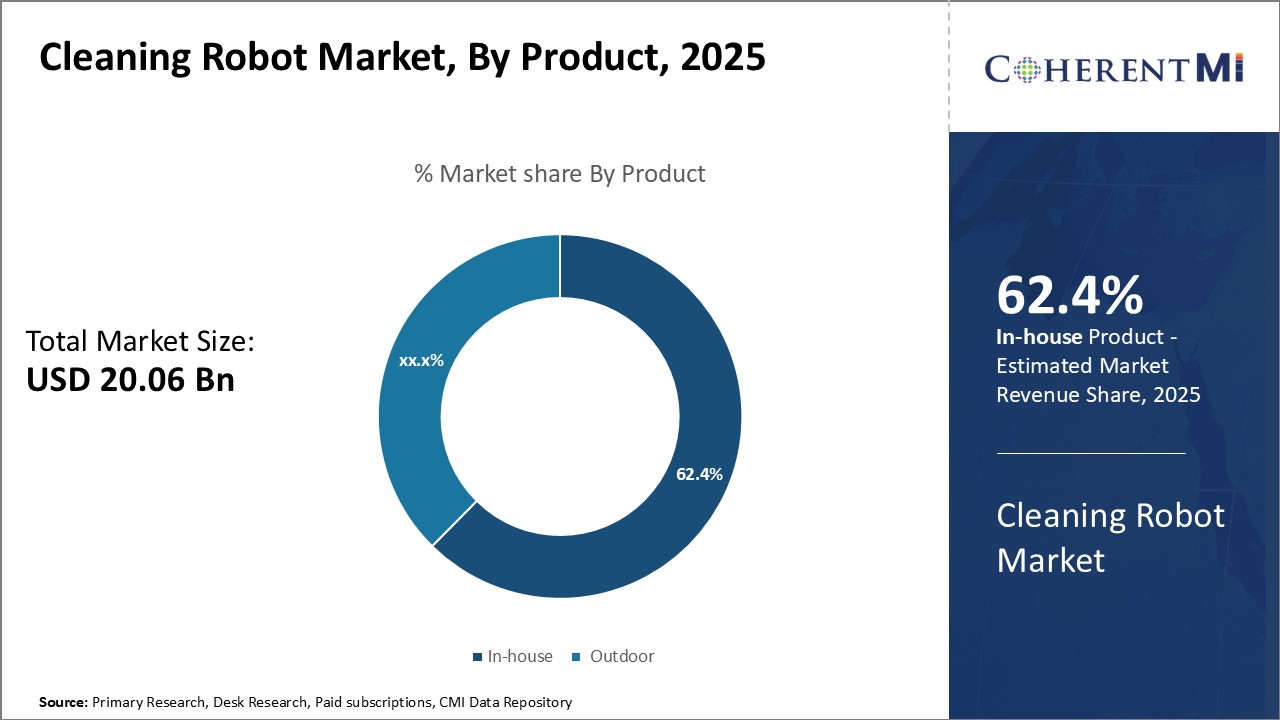Cleaning Robot Market Size - Analysis
The market trend towards more advanced robot vacuums and mops that can navigate homes and offices independently is expected to continue driving revenues over the forecast period. Standard robot cleaners with basic vacuuming and mopping are giving way to smarter models with improved mapping technologies, remote control apps, enhanced suction power and mopping functions. Voice command capabilities and options for scheduling cleans are some features end users now expect in high-end robotic cleaning devices.
Market Size in USD Bn
CAGR24.6%
| Study Period | 2025-2032 |
| Base Year of Estimation | 2024 |
| CAGR | 24.6% |
| Market Concentration | High |
| Major Players | iRobot Corporation, Ecovacs Robotics Inc., Samsung Electronics Co. Ltd., Dyson Inc., LG Electronics and Among Others |
please let us know !
Cleaning Robot Market Trends
The global pandemic has made consumers much more conscious about cleanliness and hygiene in both commercial as well as household spaces. Deep cleaning of surfaces on regular basis has become a necessity to curb the spread of viruses and other pathogens. However, performing thorough cleaning manually takes a significant amount of time and effort. Cleaning robots address this problem beautifully by automating the tedious process of cleaning floors, mopping, vacuuming and disinfecting on a scheduled basis without much human intervention. They can cover large areas thoroughly within a short time span, removing dirt, allergens, bacteria and viruses more effectively than manual cleaning. This assurance of hygienic spaces through consistent cleaning routines has become highly valued in the current environment. Cleaning robots are also found to be more practical than traditional cleaning methods as they eliminate the human error factor and ensure areas are cleaned precisely as programmed without any missed spots. Their uses are expanding beyond homes to hotels, hospitals and other commercial facilities where quality cleaning standards are of utmost importance. As hygienic indoor and public spaces assume greater importance than ever in a post pandemic world, the demand for reliable, easy to use cleaning robots is expected to grow substantially.
Market Driver - Rising Disposable Incomes and Busier Lifestyles are Pushing Consumers Towards Automated Cleaning Solutions

Market Challenge - Security Concerns Around IoT-Connected Devices, Including Risks of Data Privacy Violations
The industrial sector's increased automation of cleaning processes offers a significant growth opportunity for the cleaning robot market. Industrial facilities such as manufacturing plants, warehouses and food processing units carry out extensive cleaning operations to ensure hygiene. Currently, most of the cleaning in industrial premises is done manually which is labor intensive, time-consuming and exposes workers to health hazards. Automated cleaning robots can render these operations more productive, hassle-free and safe. Robots can effortlessly clean large areas without breaks, efficiently handling tasks such as floor cleaning, scrubbing, disinfecting, parts cleaning and more. This improves productivity. They also ensure consistency in cleaning quality every time. With industries keen to maximize efficiency through technological upgrades, there exists ample scope for cleaning robot providers to automate varied cleaning needs of industrial facilities. This offers a promising avenue for cleaning robot makers to target and expand their market.
Key winning strategies adopted by key players of Cleaning Robot Market
Product Innovation - Introducing innovative product features has helped players gain an edge. For instance, iRobot launched Roomba s9+ and s9 in 2019 with intelligent navigation and home mapping capability. This allows the robots to learn the layout of homes and offer customized cleaning. The new features were well received and boosted iRobot's sales.
Marketing & PR strategies - Aggressive marketing campaigns have aided revenue growth. For example, Ecovacs launched a "Clean Homes for All" program in 2021 where it promoted its affordable DEEBOT range through social media influencers. This led to a 35% increase in sales for Ecovacs. iRobot spends over 17% of its revenue on sales, marketing and product support. Such investments in branding have made Roomba a household name.
The above strategies of innovation, strategic partnerships, PR initiatives and after-sales support have helped key players like iRobot, Ecovacs and Roborock strengthen their market position and dominance over the years.
Segmental Analysis of Cleaning Robot Market
 Insights, By Type, Convenience and Efficiency Drive Floor Cleaning Robot Adoption
Insights, By Type, Convenience and Efficiency Drive Floor Cleaning Robot AdoptionBy Type, Floor-cleaning is expected to contribute 43.1% in 2025 owing to the immense convenience and efficiency offered by these robots. Floor cleaning is one of the most tiresome and mundane household chores. Floor cleaning robots enable users to spend their valuable time on more important tasks while the robot tidies up the floors automatically on a preset schedule or with a single click. Their advanced navigation systems and vacuuming capabilities ensure floors are deep cleaned thoroughly without any manual intervention. This saves users significant time and effort compared to traditional vacuuming methods. Floor cleaning robots particularly appeal to busy homeowners and small families who want sparkling clean floors with minimum hassle. Their 'set and forget' functionality attracts many time-strapped users.

By Product, in-house is expected to contribute 62.4% market share as cleaning robots are increasingly being used for home entertainment. In-house robots can be controlled via smartphones to clean specific areas as needed or set to roam freely interacting with pets and children. Many models feature camera eyes and facial recognition abilities turning them into quirky companions for family fun and games. Their ability to map out homes and obstacle detection skills allows them to safely manoeuver amidst furniture and toys. Some designs prioritise aesthetic appeal with toy-like looks that appeal to children. This has enabled in-house robots to evolve beyond just cleaning utilities into multi-purpose home entertainment devices, driving their popularity.
Insights, By Charging Type, Effortless Operation Boosts Automatic Charging
Additional Insights of Cleaning Robot Market
The cleaning robot market is rapidly expanding, driven by the increasing awareness around cleanliness and hygiene in both residential and industrial settings. The COVID-19 pandemic accelerated the demand for contactless and automated cleaning solutions, contributing to market growth. Asia Pacific leads the global market due to the availability of affordable robot models and rapid adoption rates, while North America benefits from technological advancements and major industry players such as iRobot. However, concerns over data security, particularly regarding IoT-connected cleaning robots, remain a challenge. Innovations in AI and machine learning are expected to reduce costs and improve efficiency, making robots more accessible to lower-income households and small businesses. The industrial sector presents a significant opportunity for market expansion, as robotic solutions are being integrated to address labor shortages and improve cleaning efficiency in large commercial spaces.
Competitive overview of Cleaning Robot Market
The major players operating in the Cleaning Robot Market include iRobot Corporation, Ecovacs Robotics Inc., Samsung Electronics Co. Ltd., Dyson Inc. and LG Electronics.
Cleaning Robot Market Leaders
- iRobot Corporation
- Ecovacs Robotics Inc.
- Samsung Electronics Co. Ltd.
- Dyson Inc.
- LG Electronics
Cleaning Robot Market - Competitive Rivalry

Cleaning Robot Market
(Dominated by major players)
(Highly competitive with lots of players.)
Recent Developments in Cleaning Robot Market
- In April 2024, LionsBot, a Singapore-based company, opened a new factory for manufacturing autonomous smart floor-cleaning robots in Southeast Asia. This facility is the largest of its kind in the region and is dedicated to the development of cleaning robotics technology.
- In February 2024, FamilyMart Co., a Japanese convenience store chain, deployed autonomous cleaning robots in 300 of its stores to address labor shortages. The robots were developed in partnership with Iwith Robotics Co.
Cleaning Robot Market Segmentation
- By Type
- Floor-cleaning
- Pool-cleaning
- Window-cleaning
- Lawn-cleaning
- By Product
- In-house
- Outdoor
- By Charging Type
- Automatic
- Manual
- By Operation Mode
- Self-drive
- Remote Control

Would you like to explore the option of buying individual sections of this report?
Ramprasad Bhute is a Senior Research Consultant with over 6 years of experience in market research and business consulting. He manages consulting and market research projects centered on go-to-market strategy, opportunity analysis, competitive landscape, and market size estimation and forecasting. He also advises clients on identifying and targeting absolute opportunities to penetrate untapped markets.
Frequently Asked Questions :
How Big is the Cleaning Robot Market?
The Global cleaning robot market is estimated to be valued at USD 20.06 Bn in 2025 and is expected to reach USD 93.53 Bn by 2032.
What will be the CAGR of the Cleaning Robot Market?
The CAGR of the Cleaning Robot Market is projected to be 24.4% from 2024 to 2031.
What are the major factors driving the Cleaning Robot Market growth?
The increasing awareness of hygiene, especially post-pandemic, is driving the demand for cleaning robots and rising disposable incomes and busier lifestyles are pushing consumers towards automated cleaning solutions are the major factors driving the Cleaning Robot Market.
What are the key factors hampering the growth of the Cleaning Robot Market?
The security concerns around IoT-connected devices, including risks of data privacy violations and high costs associated with cleaning robots, making them less accessible for some residential consumers are the major factors hampering the growth of the Cleaning Robot Market.
Which is the leading Type in the Cleaning Robot Market?
Floor-cleaning is the leading Type segment.
Which are the major players operating in the Cleaning Robot Market?
iRobot Corporation, Ecovacs Robotics Inc., Samsung Electronics Co. Ltd., Dyson Inc., LG Electronics are the major players.